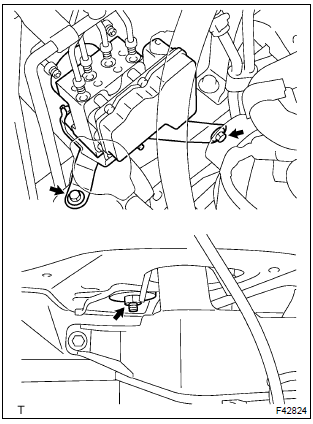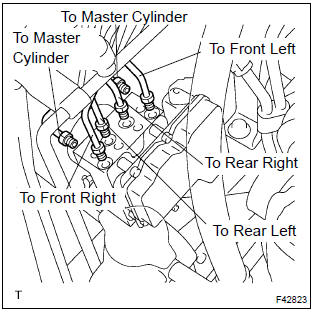Toyota Corolla (E120): Replacement
1. Drain brake fluid
Notice
: wash the brake fluid off immediately if it comes into contact with any painted surface.
2. Remove front wheel rh
3. Remove front fender liner rh
4. Remove brake actuator with bracket
- turn the latch of the actuator connector to disconnect the connector.

- Using sst, disconnect the 6 brake tubes from the brake
actuator.
Sst 09023–00100

- Attach tags or make a memo to identify the place to reconnect.

- Remove the nut, 2 bolts and brake actuator with bracket.
5. Remove brake actuator assy
- remove the 3 nuts and brake actuator from bracket.
6. Install brake actuator assy
- install the brake actuator with the 3 nuts to the bracket.
Torque: 4.7 Nvm (48 Kgf·cm, 42 in.Vlbf)
7. Install brake actuator with bracket

- Install the brake actuator with bracket with the nut and 2
bolts.
Torque: 19 nvm (194 Kgf·cm, 14 ft·lbf)

- Using sst, connect the 6 brake tubes to the correct position
of brake actuator, as shown in the illustration.
Sst 09023–00100
torque: 15.2 Nvm (155 Kgf·cm, 11 ft·lbf) - connect the brake actuator connector.
8. Install front fender liner rh
9. Install front wheel rh
torque: 103 nvm (1,050 Kgf·cm, 76 ft·lbf)
10. Fill reservoir with brake fluid
11. Bleed master cylinder
sst 09023–00100
12. Bleed brake line
13. Check fluid level in reservoir
14. Check brake fluid leakage
15. Check brake actuator with hand–held tester
Other materials:
Update contacts from phone
Operation methods differ between PBAP compatible and PBAP incompatible but OPP
compatible Bluetooth® phones.
If your cellular phone is neither PBAP nor OPP compatible, the contacts cannot
be transferred.
■ For PBAP Compatible Bluetooth® Phones
1 Select “Update Contacts from Phone” ...
Luggage compartment door
Adjustment
1. Inspect luggage compartment door panel sub–assy
check that the clearance is within the standard value.
2. Adjust luggage compartment door panel sub–assy
For forward/rearward and right/left adjustments, loosen
the bolts.
Torque: 7.0 N·m (71 kgf·cm, 62 i ...
Supplemental restraint system
Preparation
Sst
Recomended tools
Equipment
...


